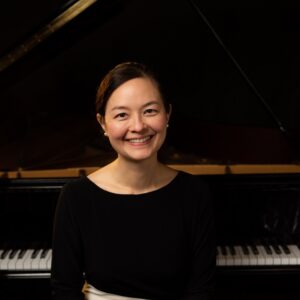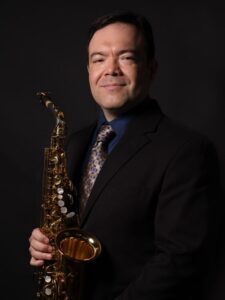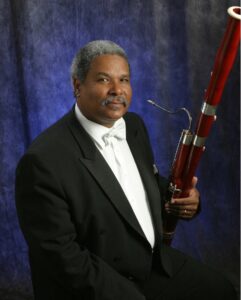Saturday, September 27, 2025, 7:30PM ~
“Mozart and More”
Shannon Theatre at Fremont High School, 1279 Sunnyvale Saratoga Rd, Sunnyvale
| Wolfgang Amadeus Mozart | Serenade No. 13 in G major, K. 525, Eine kleine Nachtmusik |
| Wolfgang Amadeus Mozart | Overture The Marriage of Figaro |
| Wolfgang Amadeus Mozart | Piano Concerto No. 21 in C major, K.467 Sandra Wright Shen, Piano |
| Jacques Ibert | Hommage à Mozart |
| Wolfgang Amadeus Mozart | Symphony No 40 in G minor, K.550 |
Guest Performers from Fremont High School
Please click here for more information about Sandra
The works featured on this program are united by their deep connection to Wolfgang Amadeus Mozart—either composed by him or inspired by his legacy. From the elegance of Eine kleine Nachtmusik to the stormy drama of Symphony No. 40, Mozart’s music captures an astonishing range of expression within the clarity and balance of the Classical style. These pieces reflect his extraordinary ability to blend structural perfection with emotional depth, whether in the sparkling wit of the Marriage of Figaro Overture or the sublime lyricism of his Piano Concerto No. 21.
Jacques Ibert’s Hommage à Mozart serves as a modern tribute, honoring Mozart’s enduring influence with a playful and graceful work that echoes the Classical aesthetic while adding a contemporary voice. Together, these compositions highlight Mozart’s timeless appeal and his profound impact on generations of composers and audiences. This program offers a journey through the elegance, intensity, and innovation that define Mozart’s musical legacy.
Sunday, October 26, 2025, 2:30PM ~
“New Horizons”
Hammer Theatre Center – 101 Paseo De San Antonio , San Jose, CA 95113
| Edward Elgar | Sospiri, Op. 70 |
| Louise Farrenc | Overture No. 1 in E minor |
| Lee Actor | Saxophone Concerto, Ricardo Martinez, Saxophone |
| Camille Saint-Saëns | Dance Macabre |
| Felix Mendelssohn | Overture Athalia |
| Cécile Chaminade | Callirhoë Suite for Orchestra, Op. 37 |
Guest Performers from Piedmont Hills High School
Please click here for more information about Ricardo
All of these works are orchestral compositions that highlight distinctive voices from different periods of classical music, ranging from the Romantic era to contemporary times. They each showcase a rich use of orchestral color and expressiveness, often inspired by extra-musical ideas—whether literary, mythological, or programmatic themes. The composers behind these works are known for blending technical mastery with emotional depth, creating music that tells a story or evokes vivid imagery.
Additionally, several of these composers—Louise Farrenc and Cécile Chaminade—are notable women who made significant contributions to classical music at times when women composers were largely underrepresented. Together, this selection celebrates both well-known masters like Saint-Saëns and Mendelssohn and modern voices like Lee Actor, illustrating a wide-ranging exploration of orchestral music’s evolution and storytelling power.
Sunday, February 1, 2026 3:00PM
“Italy by the Bay”
Italian American Heritage Foundation, 425 N 4th St, San Jose
| Antonio Salieri | Symphony in D Major, “La Veneziana” |
| Francesco Darmanin | “Foglie di Narciso”, Narcissus Leaves |
| Wolfgang Amadeus Mozart | Clarinet Concerto in A Major, K. 622 Francesco Darmanin, clarinet |
| Gioachino Rossini | Symphony in D Major “Di Bologna” |
Antonio Salieri (1750-1825)
Sinfonia in D Major, “La Veneziana”
Antonio Salieri’s Sinfonia in D major, often subtitled “La Veneziana,” is a vibrant example of late 18th-century orchestral writing that bridges the world of opera and the emerging Classical symphony. Composed around 1778–79, the work draws on overtures and intermezzi from two of Salieri’s early comic operas—La Scuola de’ Gelosi and La Partenza Inaspettata—a common practice at the time. The nickname “La Veneziana” (“The Venetian”) was likely added by a publisher rather than by Salieri himself, referencing either a Venetian performance or publication.
The three-movement Sinfonia (Allegro assai – Andantino grazioso – Presto) unfolds with theatrical flair and elegant balance. The opening movement brims with energy and rhythmic precision, displaying the bright sonorities typical of Salieri’s orchestral writing. The lyrical Andantino offers a contrasting mood, graceful and song-like, before the brisk Presto finale brings the work to a spirited close. While Salieri is best remembered as an opera composer and teacher to figures such as Beethoven and Schubert, this Sinfonia reveals his command of instrumental color and form. It stands as a charming, concise reflection of the Classical era’s fusion of dramatic vitality and structural clarity.
Francesco Darmanin (b. 1995 –)
Foglie de Narciso (Narcissus Leaves)
La prima neve The first snow falls
Quanto basta per piegare The leaf of a daffodil plant
Le foglie di Narciso Bends a little
Matsuo Basho (1644 – 1694)
“What could be lighter and more delicate than snow? How fascinating is a delicate snowflake, in its insubstantiality, a symbol of fleeting perfection!
Yet Matsuo Basho reminds us that even the smallest things, when viewed carefully, can be protagonists of great changes: small but significant undertakings that the poet, in his great sensitivity, helps us to consider.
My music, in its two sections, depicts the feeling of peace and torpor one experiences when faced with a snowy landscape – recounted by the orchestra through the slow and laborious creation of a sound, where the different instruments contribute their own timbres, with broad musical breaths. Then the magnifying glass zooms in on a small daffodil as it bows to the majestic beauty of a light snowflake: a moment recounted by the playful and serene dialogue between the notes of the wind instruments and those of the strings, now rarefied, now more concrete, until they disperse, leaving only a memory of themselves, like snow”.
Wolfgang Amadeus Mozart (1756–1791)
Clarinet Concerto in A major, K. 622
Composed in the final year of Mozart’s life, the Clarinet Concerto in A Mayor as one of the crowning achievements of the Classical concerto repertoire. Written for the virtuoso clarinetist Anton Stadler, a close friend of the composer, it was originally conceived for the basset clarinet—an instrument with an extended lower range that allowed for a uniquely rich, mellow tone. This concerto is Mozart’s last completed instrumental work, and it radiates a serene mastery that reflects his late style: graceful, clear in form, and deeply expressive without a trace of excess.
The concerto unfolds in three movements. The Allegro opens with a luminous orchestral exposition and introduces a solo part that blends lyricism and agility, setting a tone of radiant confidence. The Adagio, one of Mozart’s most sublime slow movements, floats with an almost vocal beauty—its serene, meditative melody often described as transcendent. The final Rondo: Allegro returns to a mood of playfulness and joy, full of sparkling passagework and rhythmic vitality. Throughout, the clarinet’s voice is conversational rather than showy, perfectly integrated with the orchestra. The Clarinet Concerto remains a pinnacle of Classical elegance and emotional depth.
Gioachino Rossini (1792-1868)
Sinfonia in D Major “di Bologna”
Composed c. 1808, when Rossini was still very young, this brief orchestral work reveals the emerging voice of a composer better known for his operas than his symphonic writing. The title “di Bologna” (of Bologna) alludes to the city where Rossini studied and worked in his formative years; though the piece is short in duration, it nonetheless demonstrates his mastery of orchestral color and vibrant rhythmic character. The instrumentation and form lean toward the classical sinfonia tradition, yet the energy and melodic agility already foreshadow the operatic brilliance that would soon follow.
In performance, the Sinfonia opens with brisk, lively motion, full of sparkling orchestral texture and gaiety. Yet despite its youthful exuberance, the writing is lucid and well-balanced — the thematic material is developed with clarity rather than excess, showing Rossini’s command of form even at this early stage. Critics note how the work “reveals … a full mastery … of the orchestra and that bright character and melody” characteristic of the young Rossini. Though rarely programmed compared to his overtures, this Sinfonia offers audiences a fascinating glimpse of Rossini in transition: writing for the concert hall rather than the stage, yet still bearing the unmistakable imprint of his operatic gift for drama, lyricism and momentum.
About the Composer
Francesco Darmanin (b. 1995) is an Italian clarinetist, composer, and conductor whose artistic versatility has earned him growing recognition on the international stage. A graduate with full marks and honours in Clarinet from the Conservatorio Luigi Cherubini in Florence, he continued his studies in Composition under Francesco Antonioni and in Conducting with Alessandro Cadario at both the Pinerolo Music Academy and the Cherubini Conservatory. As a clarinetist, he has served as principal clarinet of the Orchestra da Camera Fiorentina and was a member of the Accademia Orchestra of Teatro alla Scala from 2020 to 2023. He regularly collaborates with leading ensembles including the Orchestra della Toscana, Cameristi del Maggio Musicale Fiorentino, Camerata Strumentale Città di Prato, and Accademia alla Scala Orchestra, performing across Italy and Europe.
Darmanin has distinguished himself in numerous national and international competitions, winning awards such as the Premio Internazionale Crescendo (Florence), Premio Chiavari, Premio Riviera Etrusca, Premio Lions-Aldobrandeschi, Premio Silver Vinci, and Premio Internazionale Chiavari. As a soloist, he has appeared with the Florentine Chamber Orchestra, Toscana Classica, Orchestra Raffaello in Urbino, the Conservatorio Cherubini Symphony Orchestra, Orchestra Poliziana, Cherubini Wind Band, and the W. Lutosławski Symphony Orchestra in Łomża, Poland. His performing career is complemented by an equally dynamic creative life as a composer, where his music combines refined lyricism with a contemporary sensibility rooted in the European tradition.
Between 2023 and 2024, Darmanin achieved remarkable success as a composer, winning First Prize in four international competitions—Festival dei Cammini (Sansepolcro), Vladimir Mendelssohn (Ascoli Piceno), Dante700 (Prato), and the prestigious 2 Agosto Competition (Bologna). Currently Composer in Residence with I Virtuosi Italiani in Verona, his works have been performed by leading orchestras and ensembles throughout Europe and the United States, including the Orchestra Sinfonica di Sanremo, Orchestra del Teatro Comunale di Bologna, la Filharmonie, Camerata Strumentale Città di Prato, Bazzini Consort, Virtuosi Italiani, and the Thessaloniki State Symphony Orchestra. His Clarinet Concerto – The First Winter Rain (2025), premiered by Fabrizio Meloni at the Ala Festival, was met with critical acclaim. Darmanin is also an active member of the Intrigati Ensemble, led by Andrea Molino, through which he has collaborated with prominent composers including Carlo Boccadoro, Detlev Glanert, and Francesco Antonioni.
Sunday, March 1, 2026 2:30PM
“Dreams and Destinations”
Hammer Theatre Center – 101 Paseo De San Antonio , San Jose, CA 95113
| Florence Price | Andante moderato | |
| Grace Williams | Fantasia on Welsh Nursery Tunes | |
| Alan Hovhaness | Fantasy on a Japanese Woodprints for Xylophone and Orchestra Galen Lemmon, Marimba |
|
| Amy Beach | Symphony No. 2, Gaelic |
Guest Performers from Pioneer High School
Please click here for more information about Galen
These four works—by Florence Price, Grace Williams, Alan Hovhaness, and Amy Beach—reflect a shared commitment to cultural expression through orchestral music. Each composer draws inspiration from distinct national or ethnic traditions: Price weaves elements of African American spirituals into a lush Romantic idiom; Williams reimagines Welsh nursery tunes with both charm and sophistication; Hovhaness evokes the aesthetics of Japanese woodblock prints through meditative textures and exotic modes; and Beach crafts a grand symphony rooted in Irish folk melodies. Together, these pieces celebrate the diversity of global musical heritage within the classical tradition.
Equally significant is the historical context in which these composers worked. Beach, Price, and Williams were pioneering women who overcame societal barriers to establish lasting legacies in a male-dominated field. Their music—alongside Hovhaness’s spiritually rich and cross-cultural vision—offers not only artistic beauty but also a broader, more inclusive view of classical music’s possibilities. These works stand as powerful examples of how deeply personal and culturally rooted music can speak with universal resonance.
Sunday, May 24, 2026, 2:30PM ~
“Countryside to Cosmos”
Hammer Theatre Center – 101 Paseo De San Antonio , San Jose, CA 95113
| Arthur Honegger | Pastorale d’Été |
| Carlos Simon | Breathe |
| Frederick Delius | Two pieces for small orchestra |
| Vivaldi | Concerto for Bassoon in E minor no. 6, RV 484 Rufus Olivier, Bassoon |
| Ludwig van Beethoven | Symphony No. 6, Pastorale |
Please click here for more information about Rufus
These works share a profound connection to nature and the human spirit, expressed through richly textured orchestral music. From Beethoven’s Symphony No. 6 “Pastoral” and Honegger’s Pastorale d’Été, which vividly evoke landscapes and seasonal moods, to Delius’s Two Pieces for Small Orchestra that paint serene scenes of spring and summer, each piece invites listeners into an immersive sonic world. Even Carlos Simon’s Breathe channels emotional depth and a call for renewal, reflecting on human resilience and hope. Vivaldi’s Concerto for Bassoon adds a vibrant Baroque contrast, showcasing the lively, expressive qualities of the bassoon within a richly crafted orchestral dialogue.
Across these works, the composers use orchestral color and atmosphere to create vivid soundscapes that transport audiences beyond the concert hall. Whether through the impressionistic harmonies of Delius, the lyrical melodies of Beethoven, or the contemporary sensitivity of Simon, the music evokes both external environments and deep inner emotions. Spanning from the Baroque era to the present day, this diverse program highlights the enduring power of orchestral music to celebrate nature, express the human condition, and connect us across time and culture.
______________





